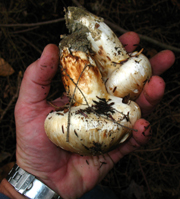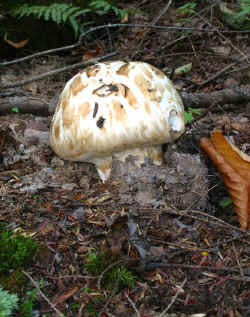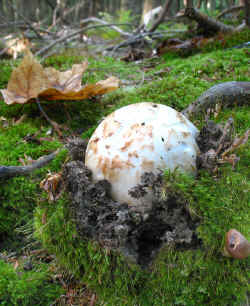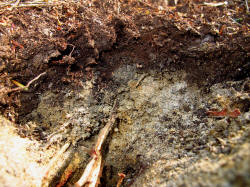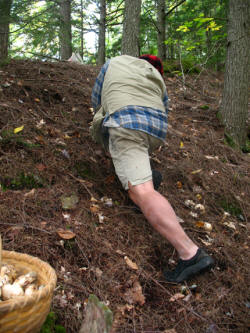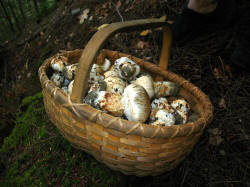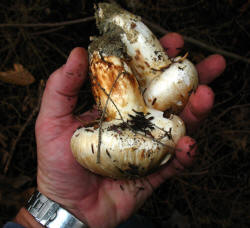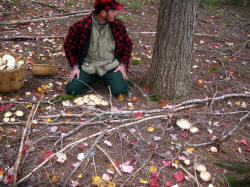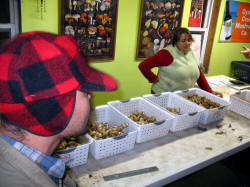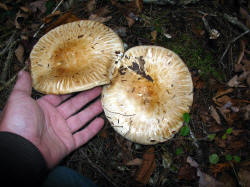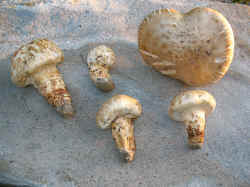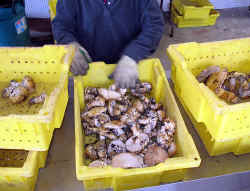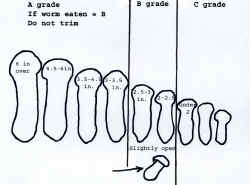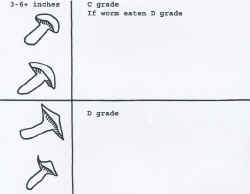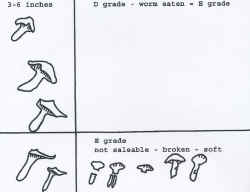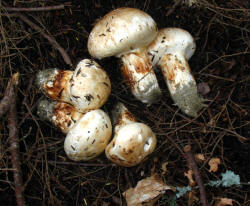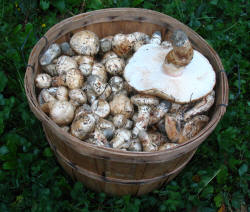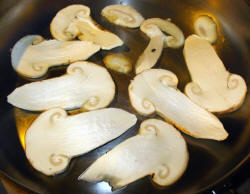|
|
Mushroom-Collecting.com A New England and Eastern Canada Edible and Medicinal Mushroom Resource |
||
|
(White) Matsutake September brings matsutake season (pronounced maht soo tah keh). Matsutake tends to bring out all kinds of people who collect nothing else and in some cases know little about any other species of mushroom. Somehow it has gotten around about their cash value. Since they sell for $6-$12+ a pound wholesale, depending on grade, finding as little as 10-15 pounds in a morning is an awfully good adventure. The folks that collect these are like morel hunters in that they are super secretive about their stands and their methods of finding them. I met people at a broker's place that had found 40 to 50+ pounds on a Sunday morning and were leaving with some very decent checks. Some people over the years have given me some bad information how to find them that I suspect was offered purposely. Matsutake is an important ceremonial mushroom in Japan often given in wooden presentation boxes to celebrate autumn. It is popular as a corporate gift and as a wedding present. It is a great honor to receive a pair of matsutake with a pair of sake glasses and commands astounding prices there. Tightly closed caps, untrimmed stems, and certain sizes are preferred. Matsutake collected for the Japan market should never be trimmed. Cap (pileus) 2-8 or more inches across. Convex at first becoming flat. White as they first emerge from the duff becoming tannish with reddish brown scales. It smells like dirty sweat socks with a hint of cinnamon. Gills (lamellae) are close and attached whitish becoming a bit tan with age. Stains pinkish brown. Stem (stipe) 2-6 or more in. long and 3/4-2 inches wide. Whitish with a white veil that breaks irregularly developing reddish brown scaly looking spots but remaining white above the soft ring. It often reaches deep into the soil or duff and can be swollen near the base then coming almost to a point. Flesh White and firm. Spores White spore print. When and where to find them (ecology) Mycorrhizal. Although they are called the "pine mushroom" they tend to grow mostly under eastern hemlock in Maine. These come in September and October thoughout Maine. Alternating cold nights and warm days seem to stimulate fruit growth. I had some people suggest that I look under red pine. I have checked the red pine on my own property and some big planted stands without success. I have never found much of anything under red pine except false morels. I do know an experienced collector who does find them under red pine but never in planted stands. They are found under pitch pine on Cape Cod. Jack pine is another possibility. Stands of older hemlocks around lakes are a good bet. Elements that may lead to success are lakes or washes through the woods, slopes or hummocks, moss, sandy, clayey soil, and especially eastern hemlock. Look especially in stands where there is little groundcover but moss. The high and steeply sloping areas are a good place to start. They may be near the upper border of a stand where hardwoods abut or a high area that is particularly steep. You may need to be part mountain goat. From the high part of the stand it's easy to look down to spot other areas. The very bottom of the hemlock stand near the water or a wet area is often especially productive. Matsutake grows in soil called spodosol or podzol. A gray clayey, sandy layer of soil is formed by a combination of drainage and evaporation. It is common in colder conifer woods. The podzol layer is the third layer below a needle layer and a thin humus layer. Usually there is a thin iron layer below the podzol and then subsoil.
Spodosol/podzol soil is an absolute requirement for
matsutake. I noticed Lactarius piperatus growing in some
matsutake areas and upon digging down to the bottom of
the stem (it usually breaks off) I found that it too,
grows in podzol soil and precedes the matsutake flush. I
was wondering if since it was a great year (2011) for L.
piperatus, that may be why it was a somewhat off year
for matsutake.
You may be able to identify possible matsutake areas by the presence of Lactarius piperatus. At least you would know podzol soil is present. At other times of the year, you could learn if a place was a possible matsutake area by bringing a trowel with you and sinking it into the soil in a good looking area to see if there is podzol. If there is no podzol, don't bother coming back. They are often hiding in plain sight. You should be looking for humps in the duff where they are popping up but not yet showing. These are likely to be the best ones with caps still unopened. There could be several if you find one. They are often found in long lines, circles or arcs. They may only pop out of the ground slightly even when mature. A matsutake can look like a half buried golf ball or a three quarters exposed baseball once above ground. Often once you see them above the duff they have passed the point of being "A grade". A matsutake patch often has fruit bodies in several stages of development. Sometimes you will spot a big open cap fruit that has turned quite brown. Fruit in earlier stages will often be right nearby. Picking the whole fruit body is the way to go. The stem can be fairly deep in the ground and you may want to get your fingers a ways into the dirt to pull it up. Stems can be particularly long if found growing in a thick mat of sphagnum moss. They are not saleable to the Japanese market with trimmed stems. It is best to be gentle in the soil and cover your holes with duff. If any mycelium comes out with the stem put it back in the hole. Preserving habitat and all indications you were there is best. Raking really should not be done as it may destroy the habitat. It may be useful to make notes on other nearby species to aid your future hunts. In 2007 I found only five all season. Most were saying it was an off year but at the broker's some had quite a few. I was successful at finding the stands of others that had already been picked. In one case a person had tied black thread to a tree branch at the edge of the road stringing it into the woods a considerable distance to their patch. I could see the holes. Dang! In 2010 I had better success because I am specifically looking for it and have purchased a boat to reach prime locations. I have gone to "matsutake school" with naturalist, forager, and master matsutake hunter Jamie Waines of Montville, Maine. I learned a great deal, saw some amazing areas, and learned some of his secret tricks of matsutake hunting. We picked over 125 lbs in a little over 3 hours at one secret location. If you really want to learn about this specialized type of hunting, he is the best. He can spot a matsutake location by the side of a lake from over a mile away. Really. Preparation These have a flavor that may take some getting used to. The "sweat socks and cinnamon" smell can be off putting. They have an unusual spicy taste. They are good sautéed or tempura fried. The smell dissipates. I started liking them pretty well after the second or third try. These do not rehydrate very well if you dry them. Making powder from the dried mushrooms for flavoring has been successful for me. Japanese use matsutake prepared with rice, in soups, and grilled, eaten with a sauce made with soy sauce and sake or vinegar. Thin sliced matsutake, kelp, soy sauce, and sake are cooked together in a rice cooker for a traditional Japanese meal. Comments Recent study indicates that northeastern T. magnivelare is genetically similar to the T. matsutake of Japan and T. nauseosum of Northern Europe. The northwestern matsutake is less similar. Some species name changes may be coming. T. caligatum is very similar but generally found under hardwoods. The kind folks at the local mushroom brokers have been good enough to let me have some of their throwaways. I have tried spreading and burying matsutake fruit bodies about under hemlocks and red pines on my own property in hopes of getting a crop. Its a better idea than sending them to the dump. Time will tell.
Find more information here: Tricholoma
magnivelare at MushroomExpert.com If you like my photography, I have products like tee
shirts, aprons, coffee cups, and other items
available here.
Use of this site will constitute your acceptance of the disclaimer. Copyright 2012 Mushroom-Collecting.com. All rights reserved. |
